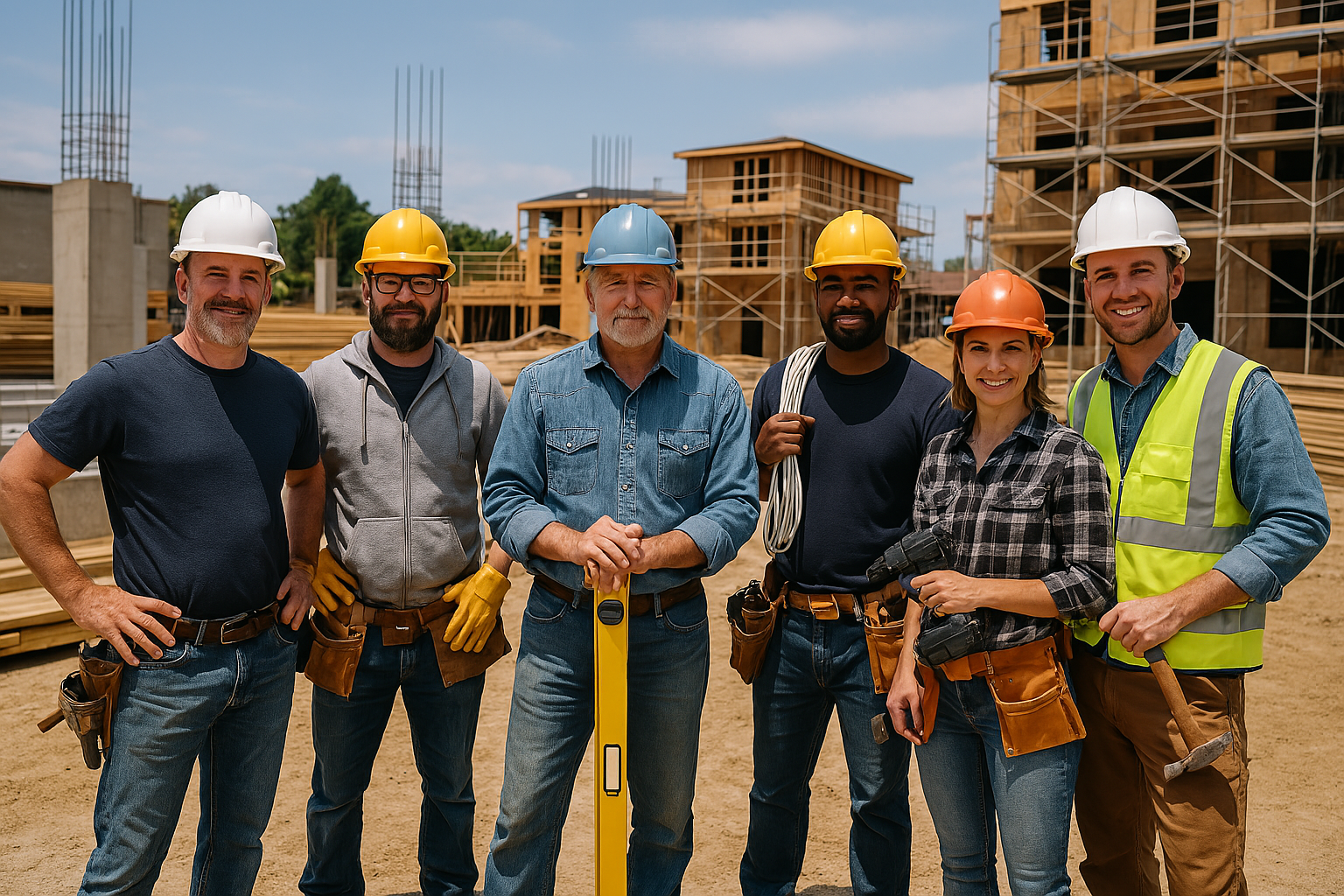
Check out our app!
Explore more features on mobile.
Landscaping: Strategic Implementation Guide for Real Estate Investors
Landscaping represents a critical investment opportunity that significantly impacts property marketability, valuation, and operational costs. For real estate investors, thoughtful landscape design and implementation deliver both immediate curb appeal advantages and long-term property performance benefits. According to the National Association of Realtors, quality landscaping can increase property value by 5-12% while potentially reducing time-on-market by 10-15%.
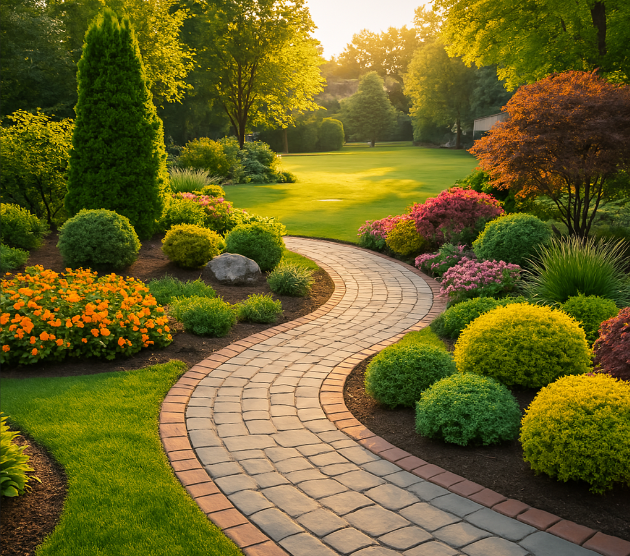
Strategic Landscape Planning for Investment Properties
Effective landscape planning requires a comprehensive approach that balances aesthetic appeal, functionality, maintenance requirements, and environmental considerations. According to the American Society of Landscape Architects, strategic landscape investments should deliver both immediate visual impact and long-term property enhancement.
Key strategic considerations for real estate investors include:
- Investment-to-value ratio – Matching landscape expenditure to property tier and market expectations
- Maintenance planning – Designing landscapes with realistic ongoing care requirements
- Regional appropriateness – Selecting elements suited to local climate and cultural preferences
- Functional prioritization – Addressing practical needs first before purely aesthetic enhancements
- Sustainability considerations – Implementing resource-efficient solutions that reduce long-term costs
Investment Benchmarks and ROI
The Landscape Contractors Association provides guidelines for appropriate landscape investment levels relative to property value:
- Entry-level properties – 5-7% of property value for initial landscaping with focus on basic curb appeal
- Mid-tier properties – 8-10% of property value with balanced hardscape and plant material
- Premium properties – 10-15% of property value with distinctive features and higher-quality materials
- Luxury properties – 15-20%+ of property value with custom design elements and premium materials
Research from Virginia Tech University indicates that different landscape improvements yield varying returns on investment:
- Basic landscape upgrade – 100-200% ROI for fundamental improvements that bring a property to neighborhood standards
- Tree installation – 100-250% ROI with mature tree specimens adding substantial value
- Professional landscape design – 150-400% ROI for comprehensive, professionally designed landscapes
- Outdoor living spaces – 80-150% ROI for patios, outdoor kitchens, and entertainment areas
- Water features – 50-100% ROI depending on design integration and regional appropriateness
Investment Perspective: The 60-30-10 Principle
The American Society of Landscape Architects recommends the following budget allocation for optimal landscaping returns:
- 60% of budget – Allocated to foundational elements with long-term value (trees, major hardscapes, grading, infrastructure)
- 30% of budget – Directed toward secondary elements that enhance functionality and appearance (shrubs, planting beds, lighting, irrigation)
- 10% of budget – Reserved for distinctive accent elements that create memorable impressions (specimen plants, decorative features, seasonal color)
This balanced approach ensures adequate investment in enduring landscape components while allowing for market-appropriate enhancements that maximize visual impact.
Climate and Regional Considerations
The Sustainable Sites Initiative emphasizes that regionally appropriate landscape design significantly impacts both performance and maintenance requirements:
- Water availability – Designing with local precipitation patterns and water restrictions in mind
- Temperature extremes – Selecting materials and plants that withstand regional temperature ranges
- Soil conditions – Addressing native soil challenges through appropriate amendments or plant selection
- Prevailing winds – Planning windbreaks or wind-resistant selections for exposed areas
- Regional aesthetics – Aligning with local design preferences and architectural styles
- Natural hazards – Adapting design for wildfire, flooding, drought, or other regional risks
Research from Colorado State University demonstrates that climate-appropriate landscaping can reduce water consumption by 50-75%, maintenance costs by 30-50%, and plant replacement by 60-80% compared to conventional approaches.
Phasing and Implementation Strategy
The Professional Landcare Network recommends a strategic phased approach for optimal landscape implementation:
- Master planning phase – Creating a comprehensive design that guides all future development
- Infrastructure installation – Implementing drainage, irrigation, and utility provisions
- Hardscape development – Constructing permanent elements like walkways, patios, and structures
- Major tree installation – Establishing primary canopy and structural plants
- Secondary planting – Adding shrubs, perennials, and ground covers
- Finishing elements – Incorporating mulch, lighting, and decorative features
This methodical approach prevents damage to completed elements, allows budget distribution over time, and provides immediate functionality while landscapes mature.
Hardscape Elements: Driveways, Walkways, and Structures
Hardscape elements create the structural framework of a landscape, providing both functionality and defining aesthetic character. According to the Interlocking Concrete Pavement Institute, these permanent features typically represent 40-60% of landscape budgets but deliver exceptional longevity and utility.
Driveway and Parking Area Options
The National Asphalt Pavement Association and Concrete Foundation Association provide comparative data on driveway materials:
| Material | Cost Range (per sq ft) | Expected Lifespan | Maintenance Requirements | Best Applications |
|---|---|---|---|---|
| Asphalt | $3-$7 | 15-20 years | Moderate (sealcoating every 2-3 years) | Rental properties, longer driveways, cold climates |
| Concrete | $5-$10 | 25-30+ years | Low (occasional cleaning and sealing) | Standard residential, warm climates, clean appearance |
| Concrete Pavers | $10-$20 | 30+ years | Low-Moderate (joint sand maintenance, occasional cleaning) | Mid to high-end properties, design-focused projects |
| Gravel/Crushed Stone | $1-$3 | 5-10 years before refreshing | High (regular regrading, weed control, periodic additions) | Rural properties, budget solutions, temporary installations |
| Permeable Pavers | $12-$22 | 30+ years | Moderate (periodic cleaning of aggregate) | Environmentally-focused properties, areas with stormwater regulations |
| Decorative Concrete | $8-$18 | 20-30 years | Moderate (periodic resealing) | Higher-end properties, design-focused projects |
Note: Costs include professional installation with proper base preparation. Source: RS Means, Interlocking Concrete Pavement Institute, National Asphalt Pavement Association (2023)
Walkways and Path Systems
The Landscape Architecture Foundation emphasizes that well-designed pedestrian circulation enhances property function and visual connection:
- Primary walkways – Main entrance paths typically 4-6 feet wide with premium materials
- Secondary paths – Connecting walks typically 3-4 feet wide with coordinating materials
- Garden paths – Casual routes typically 2-3 feet wide with simpler materials
- Material options – Considerations beyond cost:
- Concrete: Durable, versatile, moderate cost, various finishing options
- Pavers: Design flexibility, ease of repair, premium appearance
- Natural stone: Distinctive character, highest durability, premium cost
- Decomposed granite: Natural appearance, moderate cost, higher maintenance
- Mulch/wood chips: Economical, natural appearance, frequent refreshing needed
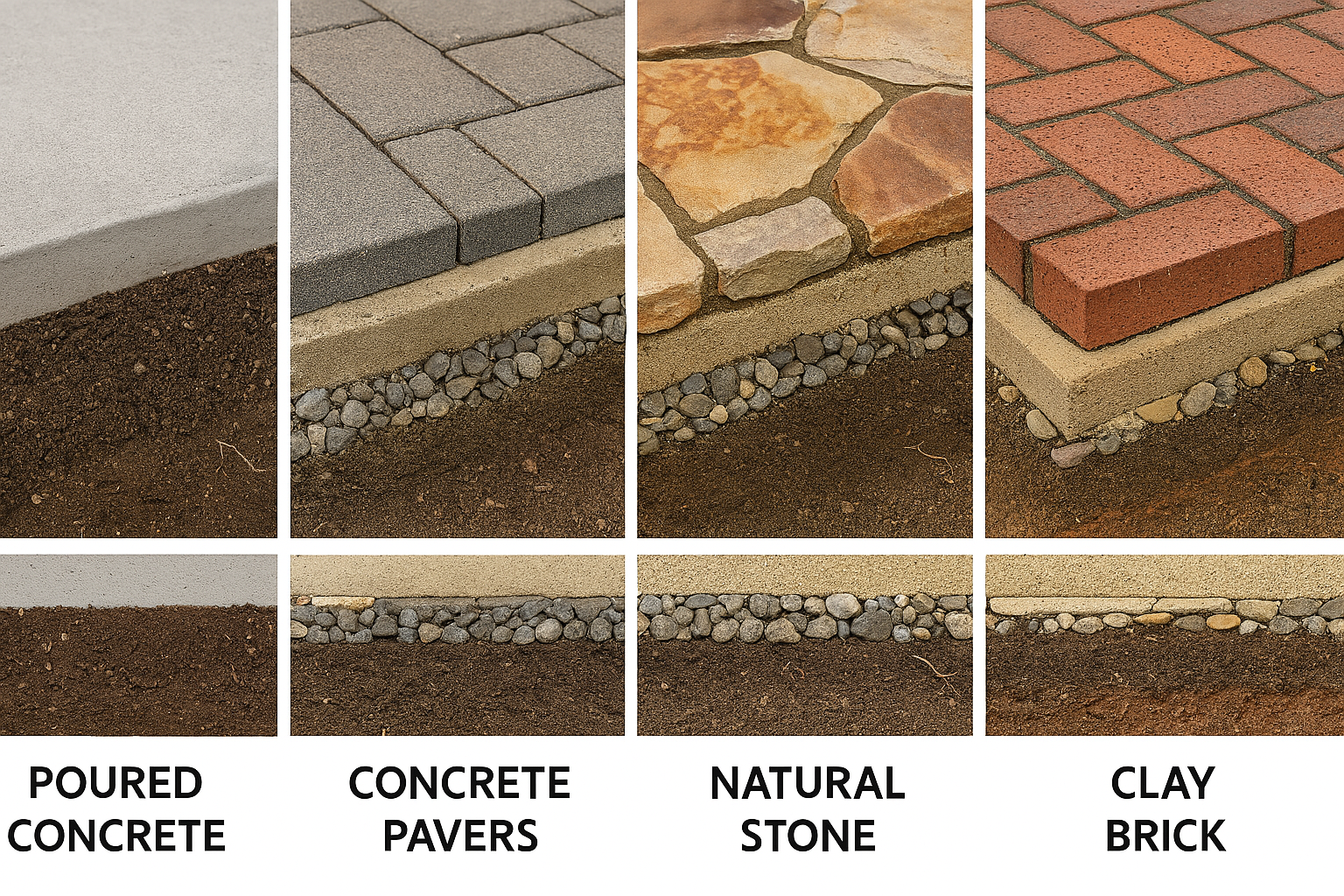
[Image: Side-by-side comparison of hardscape materials with installation cross-sections and finished appearance]
Retaining Walls and Structural Elements
The National Concrete Masonry Association provides data on retaining wall systems suitable for different applications:
- Material options – Characteristics and applications:
- Segmental block systems: $15-30/sq ft, good durability, multiple style options
- Natural stone: $25-50/sq ft, premium appearance, highest durability
- Concrete: $20-40/sq ft, maximum strength, can be faced with stone
- Timber: $15-25/sq ft, natural appearance, shortest lifespan (10-15 years)
- Gabion: $20-35/sq ft, distinctive industrial/natural hybrid, good drainage
- Design considerations – Factors affecting performance:
- Height requirements: Walls over 4 feet typically need engineering and permits
- Drainage provisions: Critical for preventing failure from hydrostatic pressure
- Proper base preparation: Compacted granular base with appropriate depth
- Geogrid reinforcement: Necessary for taller walls or challenging soil conditions
- Climate impact: Freeze-thaw considerations in colder regions
Patios and Outdoor Living Areas
The National Association of Home Builders research indicates that outdoor living spaces significantly enhance property marketability and value:
- Size considerations – Functional guidelines by purpose:
- Dining areas: Minimum 144 sq ft (12′ x 12′) for table and circulation
- Conversational areas: Minimum 100 sq ft (10′ x 10′) for seating arrangement
- Comprehensive outdoor rooms: 300-400 sq ft for multiple activity zones
- Material selection factors – Beyond cost considerations:
- Heat retention: Important in hot climates where materials like concrete and stone can become uncomfortably hot
- Slip resistance: Critical for pool areas and regions with frequent precipitation
- Maintenance requirements: Wood demands regular care while stone and concrete require minimal attention
- Visual integration: Coordination with architectural style and other landscape elements
- Enhancement options – Value-adding features:
- Shade structures: Pergolas, arbors, or shade sails extending seasonal use
- Outdoor kitchens: From simple grill stations to comprehensive cooking areas
- Fire features: Fireplaces or fire pits creating focal points and extending evening use
- Water elements: Fountains or water features adding sensory dimension
Research from Remodeling Magazine shows that well-designed patios and outdoor living spaces typically return 80-100% of their cost while significantly enhancing property marketability and reducing time-on-market.
Plant Selection and Horticultural Considerations
Strategic plant selection significantly impacts both landscape aesthetics and long-term maintenance requirements. According to the American Society of Landscape Architects, plants should be selected based on site conditions, functional requirements, visual objectives, and maintenance considerations.
Tree Selection and Placement
The Arbor Day Foundation identifies trees as the most valuable long-term landscape investments:
- Value impact – Mature trees can increase property values by 7-19% according to multiple studies
- Size categories – Selection considerations:
- Large shade trees: 50’+ mature height, provide maximum shade and value, require adequate space
- Medium trees: 30-50′ mature height, balance between impact and space requirements
- Small ornamental trees: Under 30′ mature height, suitable for space-constrained areas
- Strategic placement – Functional considerations:
- Energy savings: Deciduous trees on south/west sides can reduce cooling costs by 15-30%
- Privacy screening: Evergreens creating year-round visual barriers
- Windbreak potential: Buffer plantings reducing heating costs by 10-25% in winter
- Foundation plantings: Smaller species with non-invasive roots near structures
- Investment considerations – Maximizing returns:
- Growth rate balance: Moderate growth species offering better structure and longevity than fastest-growing options
- Initial size: Balancing immediate impact with establishment success and budget
- Disease resistance: Selecting varieties with proven performance in local conditions
- Maintenance requirements: Considering pruning needs, fruit/debris issues, and structural characteristics
Shrubs and Structural Plants
The American Nursery and Landscape Association notes that strategic shrub selection creates landscape structure and functionality:
- Functional applications – Strategic uses:
- Foundation plantings: Enhancing architectural transitions and softening building lines
- Privacy screening: Creating visual barriers with appropriate height and density
- Space definition: Establishing outdoor room boundaries and circulation guidance
- Accent placement: Highlighting key areas or architectural features
- Selection factors – Beyond aesthetics:
- Mature size: Selecting appropriate scale to minimize excessive pruning
- Growth rate: Balancing establishment time with maintenance requirements
- Pruning needs: Natural forms requiring minimal intervention vs. formal hedges
- Seasonal interest: Multiple-season performance from flowers, foliage, berries, or bark
- Investment considerations – Cost-effectiveness:
- Initial sizing: Smaller shrubs establish more quickly and cost significantly less
- Spacing strategy: Proper spacing prevents overcrowding and future replacement needs
- Evergreen ratio: Balancing year-round structure with seasonal interest
- Native adaptability: Species adapted to local conditions requiring less intervention
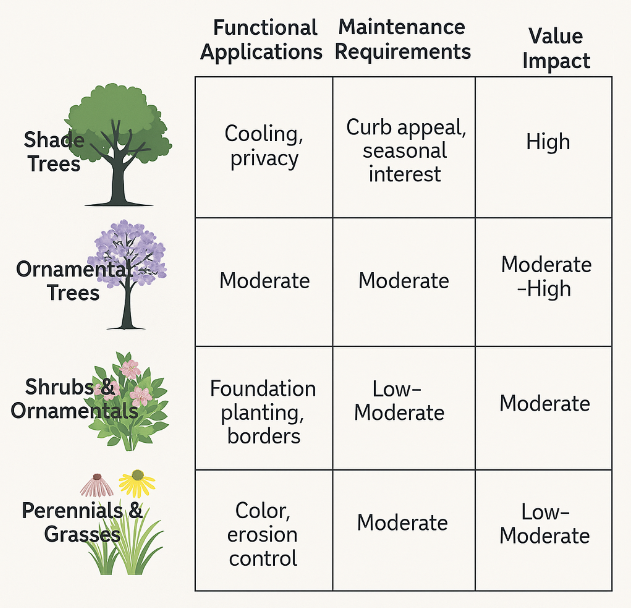
[Image: Matrix comparing different plant categories with their investment characteristics and applications]
Ground Covers and Lawn Alternatives
The Sustainable Sites Initiative provides data on ground plane treatment options and their performance characteristics:
- Traditional turfgrass – Applications and considerations:
- Establishment costs: $0.35-$0.75/sq ft for sod, $0.05-$0.10/sq ft for seed
- Maintenance costs: $0.70-$1.00/sq ft annually including mowing, fertilization, irrigation
- Water requirements: Typically 1″ per week during growing season
- Best applications: Active use areas, where walkable surfaces are needed
- Low-maintenance lawn alternatives – Options and characteristics:
- Native/adapted grass mixes: Reduced irrigation and fertilization needs
- Microclover blends: Natural nitrogen fixation reducing fertilizer requirements
- Sedge lawns: Shade tolerance with reduced mowing frequency
- Flowering lawn alternatives: Thyme, chamomile or other flowered options for low-traffic areas
- Non-grass ground covers – Strategic applications:
- Woody ground covers: Juniper, cotoneaster or other woody options for slopes and low-traffic areas
- Perennial options: Vinca, pachysandra, or other traditional spreading perennials
- Ornamental grasses: Providing texture, movement, and minimal maintenance
- Mulched beds: Simple, low-cost solution for plant-free areas
Research from the Environmental Protection Agency indicates that reducing traditional lawn areas in favor of adapted plantings can decrease landscape maintenance costs by 30-60% while reducing irrigation requirements by 50-80%.
Seasonal Color and Accent Plantings
The Society of American Florists notes that strategic seasonal color creates high visual impact with targeted investment:
- Investment strategies – Maximizing impact:
- Concentration principle: Focusing color in high-visibility areas rather than dispersing throughout property
- Entryway emphasis: Prioritizing main entrance areas for maximum impression value
- Scale consideration: Providing adequate mass for visibility from appropriate viewing distances
- Container utilization: Using planters for flexibility and focused maintenance
- Plant selection factors – Beyond appearance:
- Bloom duration: Selecting varieties with extended flowering periods
- Maintenance needs: Deadheading requirements, watering frequency, fertilization needs
- Replacement cycles: Cool/warm season rotation needs based on climate
- Climate resilience: Heat and drought tolerance for summer interest
- Return on investment considerations – Cost management:
- Perennial integration: Incorporating perennials for reduced annual replacement costs
- Bulb strategies: Using spring bulbs for early-season impact with minimal maintenance
- Property-tier alignment: Matching color investment to property positioning and revenue
- Native pollinator species: Ecological benefits with marketing advantages
Critical Quality Warning
The American Society of Landscape Architects cautions that plant selection and installation quality significantly impact long-term landscape success. Data indicates that up to 60% of landscape failures stem from improper plant selection or installation practices.
Key risk mitigation strategies: Verify plant selections with regionally-specific expertise, ensure proper planting techniques with appropriate soil preparation, and implement establishment care programs with adequate irrigation during the critical first year after installation.
Irrigation and Water Management Systems
Effective water management is critical for landscape success and operational efficiency. According to the Irrigation Association, professionally designed irrigation systems save water while improving plant health and reducing maintenance requirements.
Irrigation System Types and Applications
The Irrigation Association provides comparative data on irrigation methods for different landscape applications:
| System Type | Cost Range (per zone) | Water Efficiency | Best Applications | Maintenance Requirements |
|---|---|---|---|---|
| Spray Systems | $800-$1,500 | 60-70% efficiency | Turf areas, uniform plantings | Regular head adjustment, moderate repair needs |
| Rotor Systems | $1,000-$1,800 | 65-75% efficiency | Larger turf areas, sports fields | Annual adjustment, lower repair frequency |
| Drip Irrigation | $900-$1,600 | 85-95% efficiency | Planting beds, shrubs, trees | Filter cleaning, emitter checking, moderate repairs |
| Micro-spray | $900-$1,700 | 75-85% efficiency | Groundcovers, perennials, mixed beds | Regular cleaning, clogging issues in poor water quality |
| Smart Controller Systems | $300-$1,500 additional | Additional 15-30% water savings | Any irrigation system, larger properties | Programming updates, sensor maintenance |
Note: Costs include professional installation with typical components. Source: Irrigation Association, Landscape Contractor Association (2023)
Smart Water Management Technology
The Environmental Protection Agency’s WaterSense program documents significant efficiency gains from advanced irrigation technology:
- Weather-based controllers – Using local conditions to adjust watering:
- Water savings: 15-30% reduction compared to traditional timer systems
- Functionality: Adjusts schedules based on evapotranspiration rates and rainfall
- Cost impact: $300-800 additional investment with 1-3 year payback period
- Soil moisture sensors – Direct measurement of water needs:
- Water savings: 20-40% reduction through needs-based irrigation
- Functionality: Prevents irrigation when adequate soil moisture exists
- Cost impact: $200-500 additional investment with typical 1-2 year payback
- Flow monitoring systems – Leak detection and system protection:
- Water savings: 5-10% through leak prevention, significant damage prevention value
- Functionality: Detects abnormal flow rates indicating leaks or breaks
- Cost impact: $300-900 additional investment with variable payback based on leak risk
- Mobile control systems – Remote management capabilities:
- Water savings: 5-15% through improved management responsiveness
- Functionality: Allows remote adjustments and monitoring via smartphone or web interface
- Cost impact: $200-600 additional investment with operational efficiency benefits
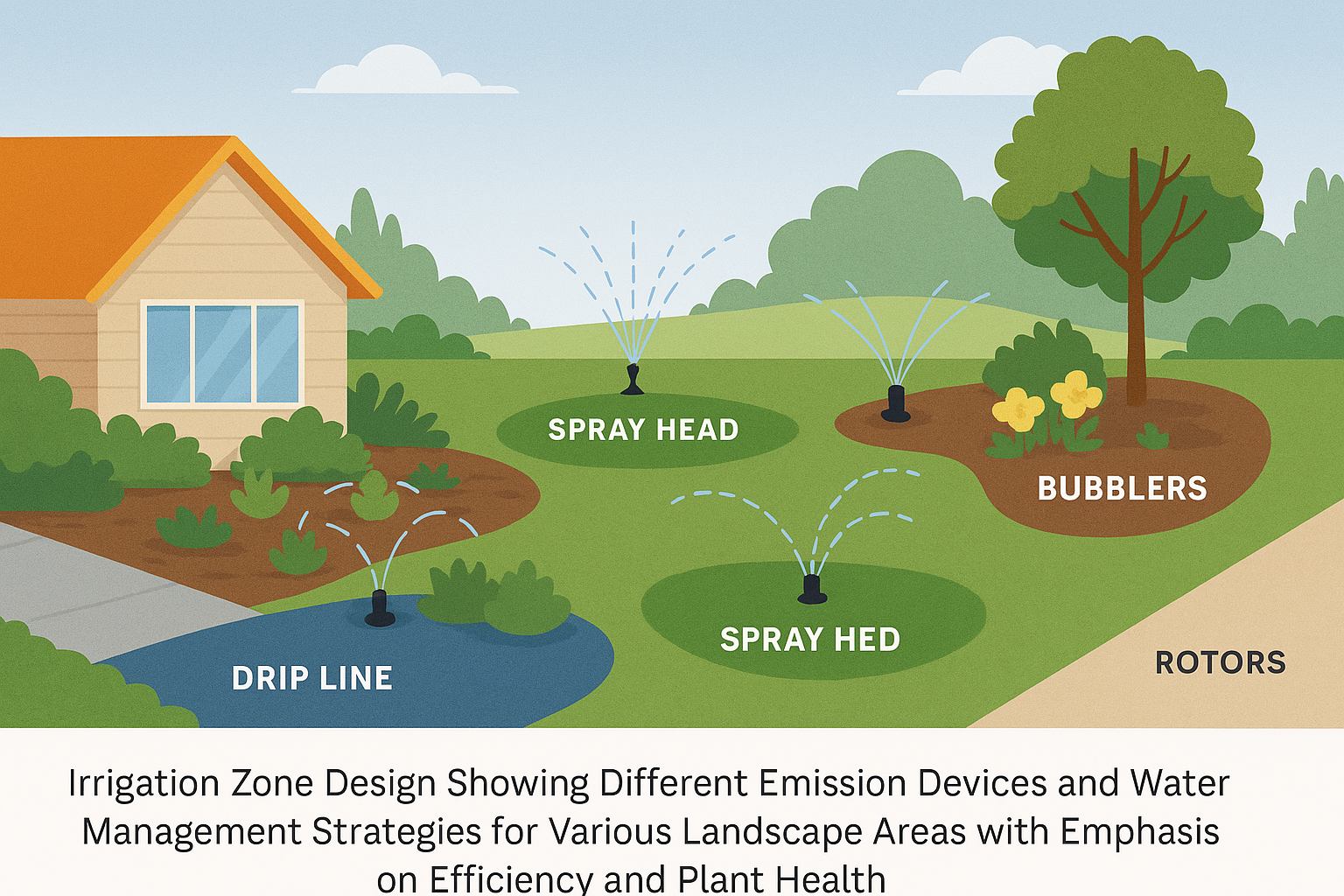
[Image: Illustration of property-wide irrigation zoning with appropriate emission devices for different plant materials]
Rainwater Harvesting and Alternative Water Sources
The American Rainwater Catchment Systems Association provides data on supplemental water source options:
- Rainwater collection systems – Capturing roof runoff:
- Collection potential: Approximately 0.62 gallons per square foot of roof area per inch of rainfall
- System cost: $2-4 per gallon of storage capacity installed
- Best applications: Areas with adequate rainfall and landscape irrigation needs
- Graywater systems – Reusing household water:
- Source volume: Typical home produces 30-40 gallons per day of usable graywater
- System cost: $800-5,000 depending on complexity and storage requirements
- Regulatory factors: Significant variation in local code allowances and requirements
- Condensate recovery – Capturing air conditioning discharge:
- Collection potential: 5-15 gallons per day per residential system in humid climates
- System cost: $300-800 for basic collection and distribution systems
- Best applications: Hot, humid regions with significant cooling system operation
Research from the University of Florida indicates that integrated water management systems combining efficient irrigation with alternative water sources can reduce landscape water consumption by 50-80% while enhancing plant health and reducing stormwater runoff.
Lighting, Technology, and Outdoor Amenities
Strategic lighting and thoughtful amenities significantly enhance property functionality, safety, and marketability. According to the Illuminating Engineering Society, well-designed landscape lighting extends usable hours, improves security, and creates dramatic aesthetic enhancement.
Landscape Lighting Systems
The Association of Outdoor Lighting Professionals provides guidelines for effective landscape illumination:
- Lighting types and applications – Strategic uses:
- Path lighting: $100-250 per fixture, safety and navigation function with decorative element
- Uplighting: $150-300 per fixture, dramatic architectural and tree highlighting
- Downlighting: $200-400 per fixture, moonlight effect from trees or structures
- Wall washing: $200-350 per fixture, gentle illumination of vertical surfaces
- Specialty lighting: $250-500+ per fixture, water features, focal points, unique elements
- Technology considerations – System components:
- LED advantages: 80% energy reduction, 10-15+ year lifespan, reduced maintenance
- Control systems: Smart controllers, zone management, scene programming
- Installation quality: Wire gauge, connection methods, fixture mounting
- Power supply: Transformer sizing, voltage drop calculation, zoning strategy
- Investment strategy – Maximizing returns:
- Safety priorities: Entries, steps, level changes, potential hazards
- Curb appeal focus: Front facade, specimen trees, entry sequence
- Usability enhancement: Patios, outdoor kitchens, gathering spaces
- Security consideration: Strategic illumination of vulnerable access points
Research from the National Association of Home Builders indicates that well-designed landscape lighting typically returns 150-400% of its cost through enhanced property value, improved security, and extended outdoor living space functionality.
Outdoor Entertainment Technologies
The Custom Electronic Design & Installation Association documents growing demand for outdoor technology integration:
- Audio systems – Options and applications:
- Landscape speakers: $300-600 per pair, weather-resistant design blending with plantings
- Surface-mounted systems: $250-500 per pair, attached to structures or under eaves
- Subwoofer enhancement: $400-800 additional, improved audio performance for larger areas
- Control integration: Zoning, source management, wireless control capabilities
- Visual entertainment – Outdoor viewing options:
- Weather-resistant TVs: $1,500-5,000, purpose-built for outdoor installation
- Projector systems: $2,000-8,000, larger viewing experience for evening entertainment
- Mounting considerations: Proper positioning, glare management, viewing angles
- Durability factors: Weather protection, secure installation, seasonal considerations
- Wi-Fi extension – Outdoor connectivity:
- Weather-rated access points: $300-700, extending reliable coverage to outdoor spaces
- Mesh network systems: $400-800, providing seamless coverage across property
- Bandwidth considerations: Supporting multiple devices and streaming requirements
- Security provisions: Maintaining network protection with extended coverage
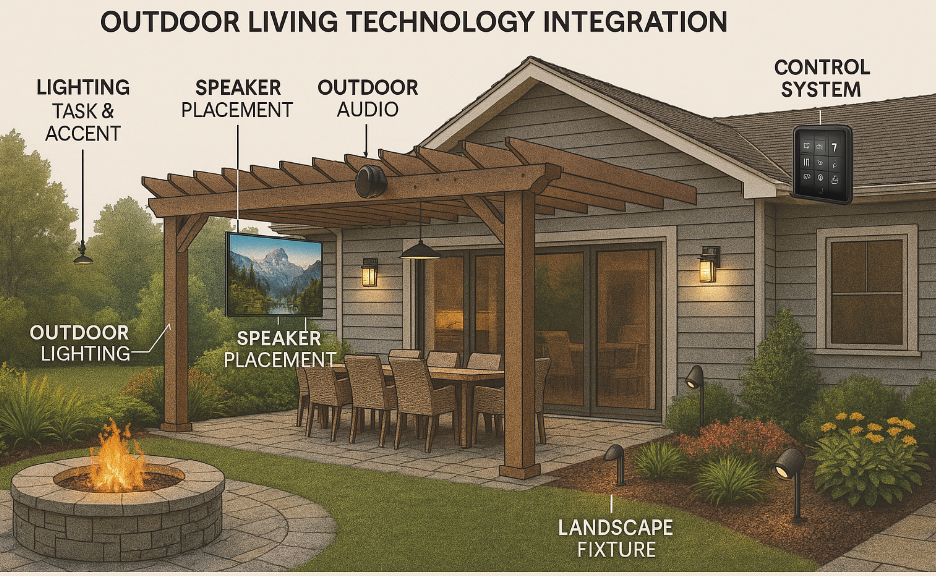
[Image: Integrated outdoor technology systems with installation details and experiential benefits]
Fire and Water Features
The Association of Professional Landscape Designers notes that specialty features create distinctive focal points and enhance user experience:
- Fire elements – Options and considerations:
- Fire pits: $2,000-6,000 installed, social gathering point with 360° access
- Outdoor fireplaces: $5,000-15,000+ installed, architectural element with directional focus
- Fire tables: $1,500-4,000, furniture integration with functional surface
- Fuel options: Natural gas, propane, wood-burning with varying convenience and operational costs
- Water features – Types and applications:
- Fountains: $1,500-8,000+, wide variety of styles from classical to contemporary
- Waterfalls: $3,000-15,000+, naturalistic or architectural options depending on design
- Reflection pools: $5,000-20,000+, contemplative elements with architectural emphasis
- Water walls: $4,000-12,000+, contemporary vertical elements for modern designs
- Investment considerations – Value factors:
- Operational costs: Water consumption, electricity usage, fuel expenses
- Maintenance requirements: Cleaning frequency, component replacement, seasonal care
- Safety provisions: Child protection, code compliance, liability management
- Return expectations: Enhancing enjoyment and marketability rather than direct ROI
Market research from the National Association of Realtors indicates that distinctive outdoor features like fire pits and water elements improve property marketability and can reduce time-on-market by 15-25% when properly integrated with overall landscape design.
Builds and Buys Approach: Landscaping Framework
At Builds and Buys, we’ve developed a systematic approach to landscape investment that maximizes property value enhancement while ensuring appropriate alignment with market positioning and operational goals:
Step-by-Step Builds: Landscape Implementation Strategy
Our comprehensive approach to new construction and renovation projects:
- Value-engineered design – Creating maximum impact with strategic resource allocation
- Installation sequencing – Implementing proper phasing for optimal long-term performance
- Plant selection protocol – Balancing immediate appeal with long-term success factors
- Contractor qualification framework – Selecting installation professionals with proven expertise
- Establishment care planning – Ensuring successful transition from installation to ongoing maintenance
Step-by-Step Buys: Landscape Evaluation Framework
For investors evaluating existing properties, our assessment framework provides critical insights:
- Landscape asset inventory – Evaluating existing features, plant material, and systems
- Condition assessment protocol – Determining current state and remaining useful life
- Enhancement opportunity analysis – Identifying high-ROI improvement options
- Maintenance requirement projection – Forecasting ongoing care needs and operational costs
- Value-gap identification – Pinpointing landscape deficiencies relative to market expectations
Step-by-Step Invest: Landscape Financial Optimization
Our investment strategies help allocate landscape budgets for maximum financial performance:
- High-impact area prioritization – Focusing resources on maximum-visibility elements
- Phased implementation planning – Strategic sequencing of improvements for cash flow management
- Maintenance-to-value optimization – Balancing care requirements with property positioning
- Water efficiency strategy – Reducing operational costs through appropriate system design
- Value-adding amenity selection – Identifying market-appropriate lifestyle enhancements
Maintenance Protocols and Long-Term Management
Effective maintenance programming is essential for preserving landscape investment value. According to the National Association of Landscape Professionals, systematic care significantly extends the functional lifetime of landscape elements while maintaining property appeal and functionality.
Seasonal Maintenance Schedule
- ☐ Spring (Early Season)
- ☐ Debris cleanup and winter damage assessment
- ☐ Soil testing and amendment application
- ☐ Pre-emergent weed control application
- ☐ Irrigation system activation and testing
- ☐ Early season fertilization appropriate to plant types
- ☐ Spring (Late Season)
- ☐ Mulch application in planting beds
- ☐ Pruning of spring flowering shrubs after bloom
- ☐ Routine mowing commencement with appropriate height
- ☐ Initial pest monitoring and management
- ☐ Annual flower installation where applicable
- ☐ Summer Maintenance
- ☐ Irrigation system monitoring and adjustment
- ☐ Regular mowing with height adjusted for season
- ☐ Pest and disease monitoring with appropriate intervention
- ☐ Selective pruning for shape maintenance
- ☐ Deadheading of flowering plants for continued bloom
- ☐ Fall Procedures
- ☐ Fall fertilization of appropriate plant material
- ☐ Leaf management and cleanup
- ☐ Cutback of perennials as appropriate for species
- ☐ Seasonal color rotation where applicable
- ☐ Irrigation system winterization
- ☐ Winter Procedures
- ☐ Dormant pruning of deciduous trees and shrubs
- ☐ Snow and ice management procedures
- ☐ Winter protection for sensitive plants
- ☐ Equipment maintenance and preparation
- ☐ Planning and budgeting for coming season
Irrigation System Maintenance
- ☐ Monthly Checks
- ☐ Controller programming review
- ☐ Visual inspection of head operation
- ☐ Adjustment of head patterns and coverage
- ☐ Checking for leaks or damage
- ☐ Verification of sensor operation
- ☐ Quarterly Service
- ☐ System pressure testing
- ☐ Filter cleaning and inspection
- ☐ Valve operation verification
- ☐ Wiring connection inspection
- ☐ Irrigation efficiency evaluation
- ☐ Annual Service
- ☐ Spring activation and testing
- ☐ Backflow prevention device testing
- ☐ Controller battery replacement
- ☐ Comprehensive system audit
- ☐ Fall winterization procedures
Hardscape Maintenance
- ☐ Paver and Stone Surfaces
- ☐ Annual power washing or cleaning
- ☐ Joint sand replenishment as needed
- ☐ Monitoring for settlement or shifting
- ☐ Weed management between pavers
- ☐ Sealer application (every 2-3 years as appropriate)
- ☐ Wood Structures
- ☐ Annual inspection for structural integrity
- ☐ Cleaning appropriate to wood type
- ☐ Refinishing/sealing on appropriate schedule
- ☐ Fastener inspection and tightening
- ☐ Monitoring for pest activity or rot
- ☐ Walls and Structures
- ☐ Inspection for cracking or movement
- ☐ Drainage system functionality verification
- ☐ Mortar/joint evaluation where applicable
- ☐ Cleaning appropriate to material type
- ☐ Sealer application where appropriate
Lighting and Electrical Systems
- ☐ Monthly Inspection
- ☐ Verification of proper operation
- ☐ Bulb replacement as needed
- ☐ Fixture cleaning as appropriate
- ☐ Adjustment of timers and controls
- ☐ Visual inspection of wiring where exposed
- ☐ Quarterly Service
- ☐ Fixture position adjustment
- ☐ Connection inspection and tightening
- ☐ Voltage testing at fixtures
- ☐ Lens cleaning and maintenance
- ☐ Controller function verification
- ☐ Annual Service
- ☐ Complete system audit
- ☐ Transformer inspection
- ☐ Wire connection integrity testing
- ☐ System adjustment for plant growth
- ☐ Technology updates as appropriate
Maintenance Budgeting Guidelines
The Professional Landcare Network provides benchmark data for appropriate maintenance budgeting:
- Annual maintenance cost ranges – Typical expenditures as percentage of property value:
- Basic maintenance: 1-2% of property value annually for fundamental care
- Standard maintenance: 2-4% of property value for comprehensive regular care
- Premium maintenance: 4-6% of property value for intensive management and high standards
- Cost allocation by category – Typical distribution of maintenance budget:
- Routine maintenance: 50-60% of budget (mowing, pruning, cleanup, basic care)
- Plant health care: 15-25% of budget (fertilization, pest management, specialized treatments)
- Seasonal operations: 10-20% of budget (leaf removal, cutbacks, seasonal color)
- Irrigation management: 10-15% of budget (monitoring, adjustment, repair)
- Service level expectations – Visit frequency by maintenance tier:
- Basic service: 26-30 visits annually (bi-weekly during growing season)
- Standard service: 38-42 visits annually (weekly during growing season)
- Premium service: 45-52 visits annually (weekly plus supplemental visits)
Research from the Building Owners and Managers Association shows that properties with consistent, quality landscape maintenance command 7-15% higher lease or sale values compared to properties with inconsistent or minimal maintenance, representing a significant return on maintenance investment.
Contractor Selection and Management
The National Association of Landscape Professionals recommends these criteria for selecting quality maintenance providers:
- Qualification verification – Essential credentials:
- Business licensing: Proper local and state requirements
- Insurance coverage: General liability, workers’ compensation, vehicle
- Industry certifications: Relevant professional credentials and training
- Specialized licenses: Pesticide application, irrigation, arborist services
- Contract specificity – Essential elements:
- Detailed scope of work: Specific tasks, frequencies, and standards
- Service calendar: Scheduled visits and seasonal operations
- Quality metrics: Measurable standards for performance evaluation
- Communication protocols: Reporting, issue management, authorization procedures
- Management best practices – Oversight essentials:
- Regular inspections: Joint property walks with defined frequency
- Performance documentation: Written evaluations and photographic records
- Proactive planning: Seasonal strategy discussions and budget reviews
- Enhancement management: Systematic approach to improvements beyond maintenance
Discover more essential real estate investment strategies with our comprehensive guides on Step-by-Step Builds, Step-by-Step Buys, and Step-by-Step Invest.
Real Estate News And Knowledge
Stay informed with the latest trends, insights, and updates in the real estate world.
Your Tools
Access your tools to manage tasks, update your profile, and track your progress.
Collaboration Feed
Engage with others, share ideas, and find inspiration in the Collaboration Feed.
